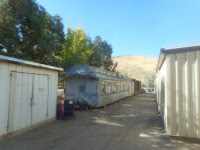Behind the visitor center at Carson City is a large storage barn and workshop. Only part of it is normally accessible to visitors.
This is V&T #25, which is operable and regularly used in revenue service.
Behind it is a combine built by Kimball and Ward in 1873, with link and pin couplers.
But the real jewel of the collection is this restored McKeen car, the only one in existence. The body served as a diner for many years, and it was completely rebuilt and operates occasionally.
The entryway:
The porthole windows are hinged at the top, and can be held up by those long hooks. Make sure they are fastened correctly, or you'll have a real headache!
Two of these unique light fixtures survived, and served as patterns for the rest to be replicated.
The one concession to practicality is the power plant. The original McKeen motor was notoriously difficult to operate and maintain, and trying to build one from scratch would be impossible, so the engine room has this modern Diesel.
The power truck looks quite authentic from the outside:
And here's a more ordinary-looking doodlebug on display, a 1926 Edwards car:
I should point out that the Friends of the NSRM have an excellent website with a complete roster, and thanks to them we can link to detailed histories of each of these items.
Outside in the yard, since there was no train running that day, they were offering handcar rides: you can propel yourself up and down the track a couple hundred feet. I managed to talk them into trading a handcar ride for a tour of the car shop.
The main object of interest in the shop at this time is V&T 17, which was built as a director's car for the Central Pacific in 1868. It is thought to have been at the driving of the Golden Spike. In 1876 it was acquired by the V&T, and later served in movies. In any case, it needs complete rebuilding.
Down the center is a large steel I beam to support the structure.
The truck pedestals have V&T cast into them:
Part of the structural problem is that the truss rods have no turnbuckles, and there are no real needle beams supported by the queen posts. It's amazing.
The end beams are collapsing, that's not unusual for old wooden cars.
Much of the exterior siding is full of holes; it looks like somebody went nuts with a drill for some reason. But it's actually due to -- wait for it -- woodpeckers! I had to laugh. I'd never come across this problem before. Of course, the siding will be completely replaced.
The side framing is this early style, section by section, instead of the much better car-length trusses built into later wooden cars. In this design, you'll notice that the truss rods appear to be an afterthought. And as I mentioned, there are no turnbuckles for adjustment.
The other car on this track is nearly complete, I think. It's a tunnel car for transporting miners who are too dirty to ride in regular passenger equipment. But you don't want rocks falling on their heads when you go through a tunnel. It was built from a flat car by the V&T is 1875, and should be fine for tourist service.
And out in back, there are several bodies of various sorts.
Here, for instance, is a 1907 Pullman combine built for the Tonopah & Goldfield:
This may look like the body of an interurban car, but it was a Hall-Scott motor car built for the Salt Lake and Utah.
And this, believe it or not, is what's left of a McKeen car built for the CGW.
The museum has an incredible collection of old equipment, most of which is not accessible, and we were running out of time, so I'll have to go back some day.





























4 comments:
The interior of that Mckeen car almost looks like something out of Jules Verne doesn't it?
C Kronenwetter
The mcKeen motor car is an amazing restoration and the ride is smooth and quiet. One of only two survivors; they just brought the body of one from Alaska down to San Diego. good luck to them!
The V&T Collection is also amazing! Many locomotives and wooden cars from the later part of the 19th century.
Ted Miles, IRM Member
Ted: Thanks for reminding us about the Cuyamaca, I had forgotten about that other McKeen car. You can easily find news articles about this project on the web. Most of them lack any pictures of what the body actually looks like today, although they can be found. It reminds me of the CSL 4001 in a couple of ways, although at least Frank isn't stuck with having to find a place to store the thing.
There are a pictures of the car in it's current condition at https://www.gofundme.com/mckeencarcuyamaca
Thank you for the comments,
Madison K.
Post a Comment